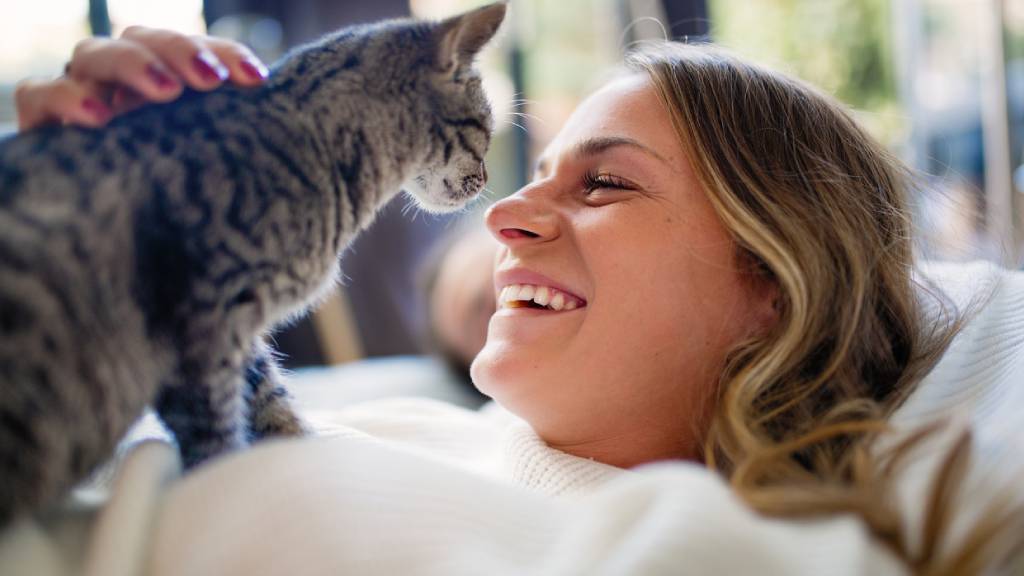Top tips for keeping an indoor cat happy and entertained

It is certainly possible for your cat to live happily contained within your property. Contained cats are less likely to become lost or injured (hit by a car, attacked by a dog or hurt by angry neighbours). Cats confined to the owner’s property are also less likely to get into cat fights and therefore less likely to have cat fight-related injuries or catch diseases such as FIV (Feline Immunodeficiency virus). This also increases the opportunity for owner-animal interaction and reduces the impact of hunting by cats and disturbance caused to neighbours. Training cats to be confined should start early when they are kittens.
Where cats are contained, steps must be taken by owners to ensure that adequate exercise and environmental enrichment is available. Cats that are confined to the owner’s property do not have to live totally indoors – access to an outdoor escape-proof enclosure can greatly increase the opportunity for activity and stimulation for confined cats and these are highly recommended. There are also specialised fences that rotate inwardly thereby keeping cats confined within the owner’s property boundaries and these can be a great strategy as cats can still have access to the backyard and the outdoors but they can’t go beyond the owner’s property.
A kitten or cat that has only ever been confined to the owner’s property is likely to cope well with living in this way as they have never known any other lifestyle. Start training early so kittens are used to being confined on the owner’s property.
Is it possible to make an outdoor cat learn to live indoors?
A cat that has experienced living outdoors may become distressed if suddenly kept totally indoors. In these cases cats may begin to display behavioural problems due to the stress of confinement and their health and welfare may become compromised. For these cats extending their access to the outdoors (via an escape-proof enclosure, specialised backyard fencing) but still within the owner’s property boundaries is recommended.
Cats that are used to access beyond the owner’s property may also be kept indoors from dusk until dawn as a way to minimise risks (as cats are nocturnal and tend to fight/wander more at night). A gradual reduction in the amount of time that the cat spends beyond the property will allow them to adjust to confinement on the owner’s property over time.
Indoor living tips
Here are some measures you can take to ensure that your home is a feline-friendly, stimulating environment where your cat is unlikely to get bored:
- Provide vertical climbing space and hiding spots.
- Provide plenty of toys to keep your cat amused – it is a good idea to have a variety of toys hidden away so you can give your cat different toys to play with on different days (ensure all toys are safe for cats, avoid string toys as these can cause an intestinal obstruction).
- Cardboard boxes with holes cut into them are great for hide and seek games. Your cat’s favourite games will be the ones that involve you as she will be able to use her instinctive pouncing behaviour and release pent up energy by chasing.
- Make sure your cat has a scratching post as cats love to scratch to keep their nails in good condition (this also helps to prevent any unwanted scratching of furniture). If you have any plants make sure they are safe for cats (check with your vet first if you’re unsure) and be aware that certain common plants, such as lilies, are fatally toxic to cats and make sure that these are not present in your house.
- Play with your cat and give them plenty of attention and company.
- Cats love to bask in the sun; make sure your cat has a nice sunny spot to lie in and window sills to sit on so they can keep an eye on the outside world and watch scenes outside which provide entertainment for them.
- Access to an enclosed outdoor escape-proof enclosure or run (non-electrified) is highly recommended so your cat has safe access to the outdoors but is still confined within your property boundaries.
- Cats are often social animals so we recommend considering having two compatible cats that get along with each other – they can keep each other company while their human owners are out.
- Confined cats can also enjoy regular walks outside on a harness and lead with their owners. This gives them new scenery and scents for mental stimulation and exercise. Train early and use reward-based training.
- Make sure that your cat always has access to clean litter and fresh water. Confined cats should have a few litter trays available per cat.
- Cat should be desexed as this will reduce territorial behaviours, such as fighting and spraying.
- Despite keeping your cat confined to your property you will still need to have her micro chipped and registered with council so that if she does slip out and become lost she can be returned to you.
- Pet insurance can be a good idea, as even an indoor cat may succumb to an occasional illness and visits to the vet can be expensive.
21 Jun 2013